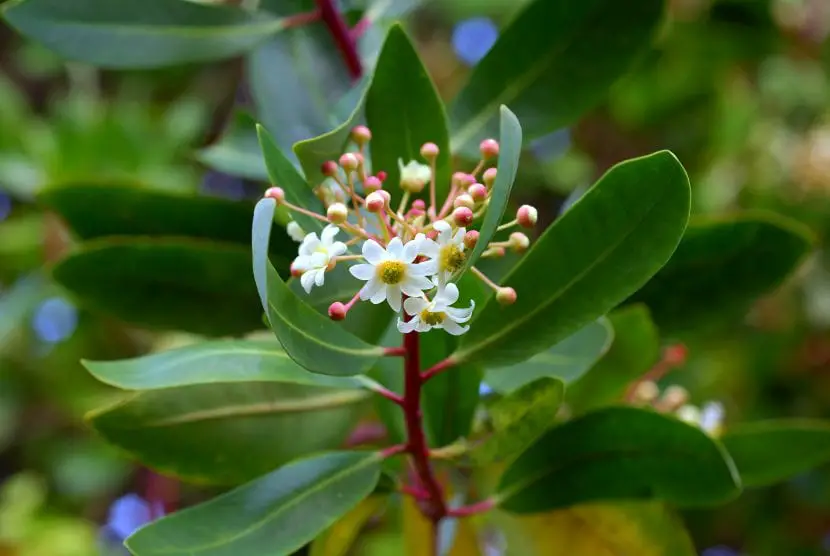
The cinnamon is a tree with great ornamental value It can be grown in temperate regions without any problem. Although it is not one of those that provides good shade, the bark of its trunk, its leaves and flowers are so beautiful that it is worth making room for it in the garden.
Do you want to know him better? 🙂
Origin and characteristics of cinnamon

Our protagonist is a evergreen tree originally from Chile and Argentina known as canelo or drimis. Its scientific name is Drimys winteri. It is characterized by have an almost pyramidal bearing, with a straight trunk that reaches 15-20 meters. The leaves are simple, leathery, green on the upper side and whitish on the underside, they measure 10x3cm, and have a slightly recurved smooth margin. The flower is white with a yellow center and the fruit is a bluish berry.
It is a plant with a medium-fast growth rate, so you can have a very interesting specimen in your garden in just a few years. In addition, you should know that its bark has medicinal properties: having a high content of vitamin C, it is used to combat scurvy.
Sacred tree of the Mapuches
As a curiosity, it is interesting to know that in the Mapuche culture the canelo is considered a sacred tree. In fact, there is usually one planted on the altars -called hostages- used by them during ceremonies.
On the other hand, the Chilean Huilliche tribe associates this plant with witchcraft.
What are their cares?

If you want to have a copy, we recommend that you provide it with the following care:
Location
It is a tree that must be outside, in full sun or, better, in semi-shadeat least while I’m young. Likewise, it is important that, if it is on the ground, it is planted at a distance of 5-6 meters from pipes, walls, walls, etc. to avoid problems.
Earth
- the garden: it must be rich in organic matter, light and deep, with good drainage.
- Flower pot: fill it with universal growing medium (for sale here!) mixed with 30% of perlite. Anyway, you have to know that it cannot be cultivated throughout its life in a pot due to the size it reaches. But I will also tell you that if you get one of the big ones, those that measure about 1 meter in diameter by about the same height, and you prune it regularly, it is possible to have it very healthy.
Irrigation
The frequency of irrigation will change throughout the year. Thus, while in summer it will be necessary to water frequently if the weather is rather dry and warm, in winter it will not be necessary to worry so much about this issue. Taking this into account, It will be watered an average of 2-3 times a week in summer, and somewhat less the rest of the year.
Whenever you can, use rainwater, as it is the best that the plants can receive.
Planting or transplanting time
In springwhen the frosts have passed. If it is potted, transplant every two years, or sooner if you see roots coming out of the drainage holes.
Multiplication

Image – Wikimedia Commons / Inao Vasquez
The cinnamon multiplies by seeds in spring. Direct sowing in seedbed, outside protected from direct sun. You can follow this step by step:
- First, fill a seedbed (flowerpot, milk or yogurt containers, or whatever you have more within reach as long as it is waterproof and you can make some holes for drainage) with seedbed substrate (for sale here!) or universal (for sale here!).
- Then sow the seeds on the surface so that they are separated from each other.
- Then cover them with a thin layer of substrate.
- Then sprinkle with copper or sulfur or spray them with fungicide spray (commercially available here!). This way the fungi will not be able to damage them.
- Finally, water.
Keeping the substrate moist but not flooded, they will germinate for about fifteen days.
Pruning
Late winter remove dry, diseased or weak branches, and trim those that are overgrown using pruning tools previously disinfected with pharmacy alcohol or a few drops of dishwasher.
Rusticity
Withstands cold and frost up to -6ºCbut excessive heat (30ºC or more) hurts you.
What uses is it given?

Image – Wikimedia / Krzysztof Ziarnek, Kenraiz
Ornamental
The cinnamon tree is a very decorative and easy-to-care plant that will surely give you great satisfaction. Its flowers, although it is true that they are not large, they are beautiful. What’s more, the plant has an elegant bearingideal to make the garden look even more beautiful.
Medicinal uses of cinnamon
Without a doubt, it is the most common use of it. Especially the bark is rich in tannins and vitamin Cwhich is used to treat scurvy and as an antibacterial.
As an external use it is effective to clean and treat wounds, whether they are infected or not.
What did you think of the cinnamon tree? Have you heard of him?

